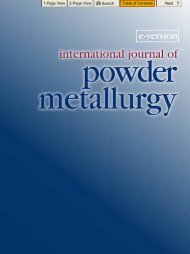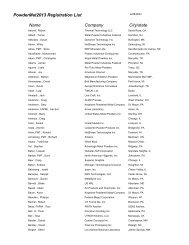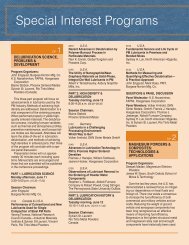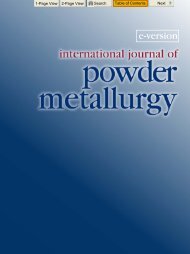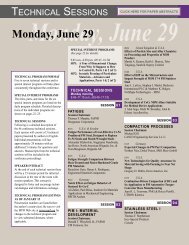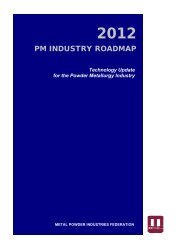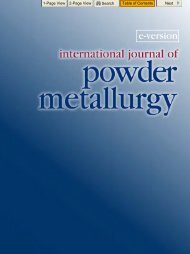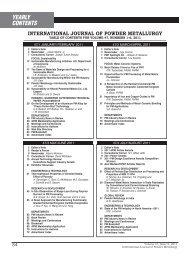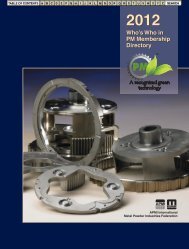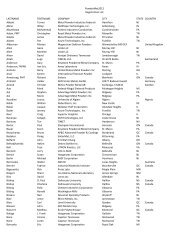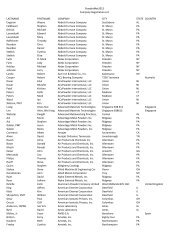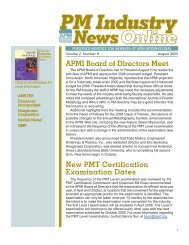E-IJPM: Vol. 44/4 - MPIF
E-IJPM: Vol. 44/4 - MPIF
E-IJPM: Vol. 44/4 - MPIF
Create successful ePaper yourself
Turn your PDF publications into a flip-book with our unique Google optimized e-Paper software.
TUNGSTEN FILAMENTS—THE FIRST MODERN PM PRODUCT<br />
46<br />
day, and one lamp calls for four feet of my wire.”<br />
On March 11, 1907, he wrote: “Dear Mother, it<br />
looks now as though I have made a great improvement<br />
in my filament method. Unless a bug develops<br />
(and I don’t expect it now) my improved<br />
method will be very hard to beat, and for the large<br />
filaments at any rate I very much doubt whether<br />
anything can touch it. The improvement consists<br />
in the addition of a small quantity of another<br />
metal, bismuth, to my mixture. It cuts the time<br />
per filament from minutes down to four seconds.”<br />
One month later he wrote, “I am also pleased to<br />
see that I am getting the credit for my recent discovery<br />
that tungsten is a ductile metal below red<br />
heat. I found that these filaments which are so<br />
brittle cold can readily be bent into any shape by<br />
heating slightly.”<br />
EARLY COOLIDGE BULB AND MAZDA BULBS<br />
GE made the first public announcement of ductile<br />
tungsten wire in 1910 but changed over to the<br />
Coolidge process during late 1910. The company<br />
scrapped about $500,000 worth of equipment as<br />
well as another $500,000 worth of unsold filament<br />
lamps.<br />
In 1907, 90 percent of domestic incandescent<br />
lamp sales were carbon. By 1916 an estimated 85<br />
percent were made from tungsten. Lamps made<br />
with ductile tungsten filaments were marketed by<br />
GE in 1911 under the Mazda brand in 25, 40, 60,<br />
100, and 150 watt levels, lasting up to 1,000 h,<br />
Figure 5 and Figure 6.<br />
A GE advertisement for Edison Mazda Lamps<br />
said: “For the same money that you now pay for<br />
the old-style carbon lamp, you can have your<br />
choice of three times as much light in each room.”<br />
COOLIDGE PATENTS<br />
Coolidge began filing patents in 1909 on dies<br />
and die supports, and was awarded the patent for<br />
ductile tungsten (U.S. Patent 1,082,933) on<br />
December 30, 1913, Figure 7. GE granted licenses<br />
to several companies to make ductile-tungsten<br />
wire for incandescent electric lamps. However,<br />
Coolidge’s 1913 patent was challenged by the<br />
Independent Lamp & Wire Co., Weehawken, New<br />
Jersey, and invalidated in 1927 because it was<br />
not an invention as defined by patent law.<br />
Many competitors joined the business including<br />
the Independent Lamp & Wire Company producing<br />
wire for Sylvania bulbs. Callite Tungsten<br />
Corporation followed, as well as Westinghouse,<br />
Mallory Metallurgical, and GTE Sylvania, Inc.<br />
OTHER TUNGSTEN DEVELOPMENTS<br />
Coolidge’s seminal work on tungsten filaments<br />
opened the door to inventing a vacuum tube for<br />
generating X-rays known as the “Coolidge tube.”<br />
It became the first stable and controllable X-ray<br />
generator for medical and dental use and replaced<br />
gas-filled tubes with platinum targets. Another<br />
well-known GE researcher, Irving Langmuir,<br />
found that he could obtain a controllable electron<br />
emission from one of Coolidge’s hot tungsten filaments<br />
in a high vacuum instead of a gas. Coolidge<br />
installed a heated tungsten filament in an X-ray<br />
tube with a tungsten filament cathode and a<br />
tungsten target. He also developed tungsten contacts<br />
for electrical switches used in automotive<br />
ignition systems. Many other commercially successful<br />
tungsten products followed.<br />
Figure 5. Early<br />
Coolidge bulb<br />
Figure 6. Mazda<br />
brand GE<br />
light bulbs,<br />
1911–1913<br />
<strong>Vol</strong>ume <strong>44</strong>, Issue 4, 2008<br />
International Journal of Powder Metallurgy



